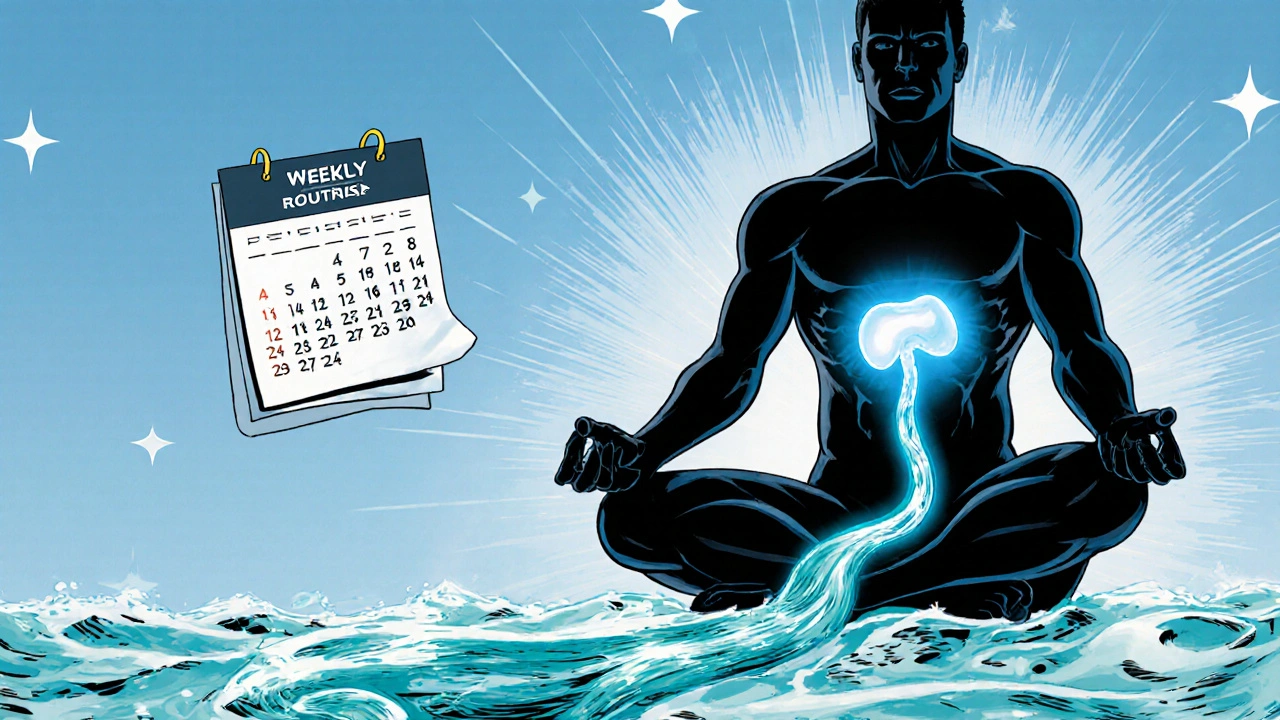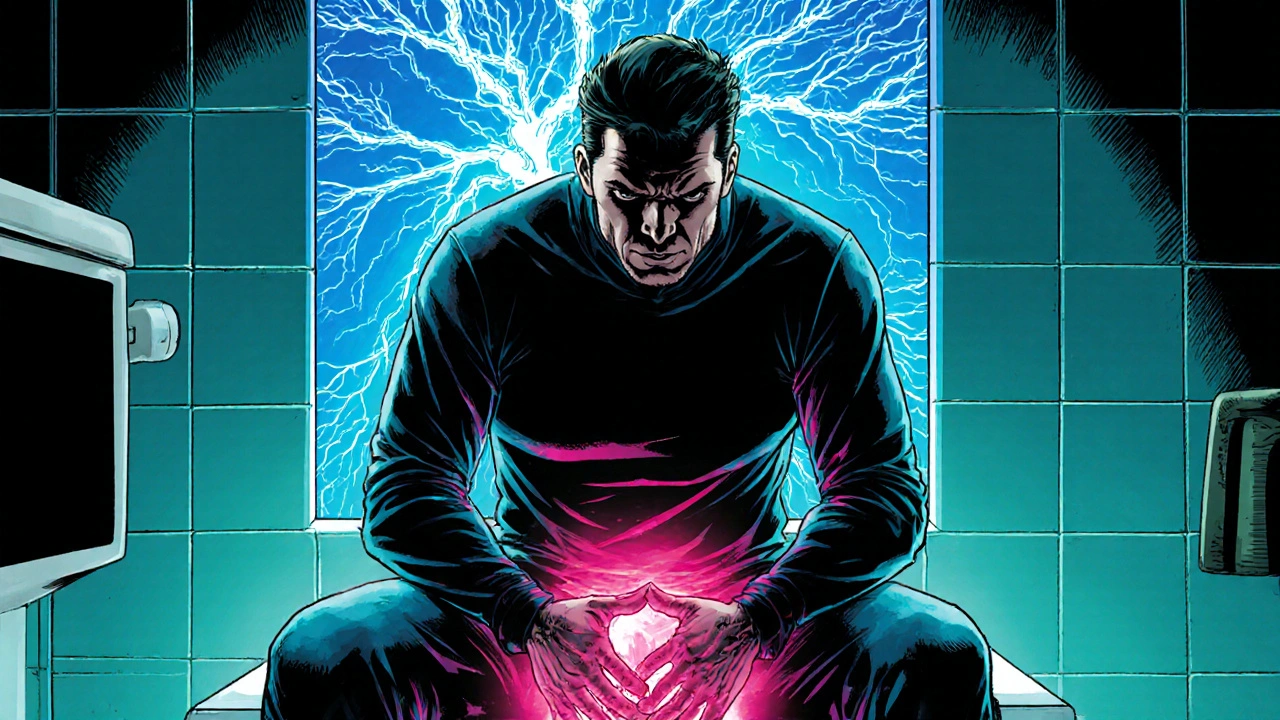Yoga & Meditation Selector for Urinary Health
This tool will help you identify the most effective yoga poses and meditation techniques based on your specific symptoms. Answer a few questions below to get personalized recommendations.
When someone experiences difficulty urinating is a condition where starting, maintaining, or completing the urine stream is unusually hard or painful, it can feel frustrating and sometimes embarrassing. Stress, weak pelvic floor muscles, or an over‑active nervous system often lie behind the problem. The good news? Gentle movement and focused breathing can calm the body, strengthen the muscles that control flow, and restore confidence.
Quick Summary
- Stress and a tense autonomic nervous system often worsen difficulty urinating.
- Yoga poses that target the pelvic floor, core, and lower back improve muscle tone and blood flow.
- Mindful meditation lowers cortisol, relaxes the bladder, and can shorten the time needed to start urinating.
- Start with short, daily sessions; progress gradually to avoid over‑exertion.
- Seek medical advice if symptoms persist, worsen, or are accompanied by pain or fever.
Why the Body Gets Stuck: The Core Physiology
Three main factors play into difficulty urinating:
- Pelvic floor dysfunction - The muscles that wrap around the bladder and urethra can become too tight (hypertonic) or too weak (hypotonic). Both extremes interrupt the smooth opening and closing of the urinary sphincter.
- Stress‑induced nervous activity - The autonomic nervous system controls involuntary actions like bladder contraction. When chronic stress spikes sympathetic tone, the bladder stays in a “hold‑on” mode.
- Underlying medical conditions - Benign prostatic hyperplasia (BPH), urinary tract infections (UTIs), or interstitial cystitis can physically block flow or cause painful urgency.
Addressing the first two items with movement and breath is where yoga and meditation shine.

How Yoga Directly Helps the Pelvic Floor
Yoga is more than stretching; it’s a mindful activation of muscle groups that support the lower abdomen. Below is a concise table that matches popular poses to the specific structures they engage.
| Pose | Target Area | How It Helps |
|---|---|---|
| Supta BaddhaKasana (Reclining Bound Angle) | Pelvic floor & inner thighs | Gentle stretch releases tension, allowing the sphincter to relax. |
| SetuBandhaSarvangasana (Bridge) | Lower back, glutes, diaphragm | Strengthens supporting muscles and improves diaphragmatic breathing. |
| Malasana (Garland Squat) | Hip flexors, perineum | Activates deep pelvic muscles, promoting tone without over‑compression. |
| Cat‑Cow (Marjaryasana‑Bitilasana) | Spine, abdominal wall | Creates rhythmic movement that massages the bladder and urethra. |
| Ujjayi Breath (Victorious Breath) - practiced in any pose | Diaphragm, vagus nerve | Activates parasympathetic response, lowering stress hormones. |
Step‑by‑Step Routine (15‑Minute Daily Practice)
- Center and Breathe (2min) - Sit cross‑legged, close eyes, and inhale through the nose for a count of four, exhale through the mouth for a count of six. This simple Ujjayi breath stimulates the vagus nerve and calms the autonomic system.
- Cat‑Cow Flow (3min) - On all fours, arch the back (cow) then round it (cat) with each breath. Aim for 10 cycles. The motion gently massages the bladder area and releases tightness in the lower back.
- Bridge Pose (3min) - Lie on your back, knees bent, feet hip‑width. Press into the feet, lift hips, clasp hands under the back. Hold 30seconds, rest 15seconds, repeat three times. This strengthens the glutes, which indirectly support pelvic floor stability.
- Malasana (Garland Squat) (3min) - From standing, lower into a deep squat, bring palms together at the heart, and gently press elbows against the inner knees. Stay 1minute, breathing slowly. The squat opens the pelvic outlet and encourages proper alignment for urination.
- Reclining Bound Angle (4min) - Lie on your back, soles of the feet together, knees falling open. Place a pillow under the head, breathe into the belly, and stay for the remainder of the session. This final relaxation allows the nervous system to shift into a parasympathetic state, making it easier to start the urine stream later.
Do this routine once a day, preferably before bedtime. Consistency builds muscle memory and reduces the “fight‑or‑flight” tone that blocks flow.
Meditation Techniques That Calm the Bladder
Meditation works hand‑in‑hand with yoga because it targets the mental side of the equation. Two simple practices are especially useful.
1. Body Scan for the Lower Pelvis
- Find a comfortable seated or reclined position.
- Close your eyes and bring attention to the breath for 30seconds.
- Slowly shift awareness down to the pelvic region. Notice any tightness, heat, or pressure without judgment.
- On each exhale, imagine the tension melting away like warm water.
- Continue for 5minutes, then gently come back to the room.
Research from the University of Miami (2023) showed that a 5‑minute body‑scan lowered bladder‑training stress scores by 28%.
2. Guided Visualization: The Flow Stream
- Sit upright, spine straight, and inhale deeply.
- Picture a gentle river flowing smoothly through a valley. Your bladder is the river’s source; the urethra is the channel that carries water downstream.
- With each breath, visualize the water moving without obstruction.
- Hold this image for 3‑4 minutes, letting the mental cue reinforce physical relaxation.
When the mind creates a calm visual, the sympathetic nervous system backs off, allowing the sphincter to open more easily.

Safety Tips and When to See a Doctor
Yoga and meditation are low‑risk, but a few precautions keep you safe:
- Start slowly. If you feel light‑headed during Bridge, lower the hips or place a folded blanket under your sacrum.
- Avoid over‑stretching the perineum. Excessive force in Malasana can worsen hypertonic muscles.
- Watch for pain. Sharp or burning pain during any pose may signal an underlying infection or inflammation.
- Hydrate. Adequate water intake keeps the urine dilute and supports bladder health.
- Medical red flags. Fever, blood in urine, severe urgency, or a sudden change in stream warrants a clinician’s evaluation.
If you have a diagnosed condition such as BPH, interstitial cystitis, or recent pelvic surgery, consult your urologist before beginning a new routine. They can tailor the program to your specific limitations.
Putting It All Together: A One‑Week Plan
Below is a simple schedule that blends movement, breath, and mental focus. Adjust the timing to fit your lifestyle.
| Day | Activity | Duration |
|---|---|---|
| Monday | Full 15‑minute routine + Body Scan | 20min |
| Tuesday | 15‑minute routine (skip Malasana) | 15min |
| Wednesday | Guided Visualization only | 10min |
| Thursday | Full routine + Body Scan | 20min |
| Friday | Gentle walking + 5‑minute breath work | 15min |
| Saturday | Full routine + Visualization | 20min |
| Sunday | Rest or light stretching | Optional |
Stick with the plan for at least two weeks. Most people notice a smoother start to the urine stream and reduced urgency by day10.
Frequently Asked Questions
Can yoga replace medication for urinary problems?
Yoga is a supportive tool, not a cure‑all. For mild pelvic floor tension or stress‑related retention, regular practice can reduce the need for medication. However, if an infection, prostate enlargement, or stones are the cause, medical treatment remains essential.
How long before I see results?
Most beginners feel a difference in bladder comfort after 7‑10 days of consistent practice. Full muscle conditioning may take 4‑6 weeks.
Is it safe to do these poses during pregnancy?
Yes, with modifications. Pregnant people should keep the hips wider in Malasana, avoid deep backward bends in Bridge, and use props for support. Always check with a prenatal care provider first.
What if I have a urinary tract infection?
Focus on gentle breathing and avoid poses that compress the lower abdomen until the infection clears. Antibiotics and increased fluid intake are the primary treatment.
Do I need special equipment?
A yoga mat, a bolster or folded blanket for support, and a quiet space are enough. Props help keep the body safe while you build strength.

Stephen Davis
September 6, 2025
Hey folks, great rundown! I’ve tried the Bridge Pose and it really helped loosen up my lower back, which seemed to be crowding my bladder. Mixing in the Ujjayi breath while doing Cat‑Cow gave me a calmer headspace before bedtime. If anyone’s curious, I’d say start with just two minutes of breath work and build from there – the body usually follows the mind’s cue. Keep it gentle and listen to your body, and you’ll notice the stream flowing smoother in a week or so.
Richard Phelan
September 9, 2025
Alright, I must interject – the article’s tone is a bit too "zen" for my taste. While the suggestions are solid, the grammar in the “Step‑by‑Step Routine” section is riddled with inconsistencies (e.g., “Sit cross‑legged, close eyes” should have a comma after “cross‑legged”). Also, let’s not pretend yoga can replace a doctor’s prescription for a urinary tract infection. The author should include a disclaimer about seeking professional care before starting any regimen – otherwise it feels like a reckless health hack.
Louie Lewis
September 13, 2025
One must question the underlying premise of commercializing ancient practices. Are we truly benefiting, or are we feeding a market that thrives on fear of bodily functions? The advice sounds plausible yet veiled in mysticism; skepticism is warranted.
Eric Larson
September 16, 2025
Wow!!! This is exactly the kind of practical guide we need!!! The step‑by‑step routine is clear, concise, and the breath work integration is a game‑changer!!! I personally love the way the author ties the vagus nerve activation to stress reduction – it’s science meets mindfulness!!! Keep the flow coming, and maybe add a quick FAQ for newbies!!!
George Kata
September 20, 2025
Nice addition, Eric! Just a tiny note – in the Bridge Pose description, "press into the feet" could be clearer if we say "press firmly into the feet". Also, watch out for the typo "definately" in the FAQ; it should be "definitely". Other than that, the guide is solid and very helpful for beginners.
Nick Moore
September 23, 2025
Super encouraging guide! I’ve been hesitant to try yoga for bladder issues, but the gentle approach here feels doable. The one‑minute Malasana is a great way to start without over‑doing it. Keep spreading the positivity – it makes a huge difference for those of us dealing with awkward health topics.
Veronica Lucia
September 27, 2025
Reflecting on this, it’s interesting how the body and mind intertwine. The body‑scan meditation isn’t just a relaxation tool; it cultivates a mindful awareness of the pelvic region, which can subtly shift autonomic responses. In philosophy, we often speak of the unity of perception and physicality – this practice exemplifies that.
Sriram Musk
September 30, 2025
Thank you for the comprehensive guide. I would like to suggest a minor grammatical improvement: replace "when you feel light‑headed during Bridge" with "if you feel light‑headed while performing Bridge" for better clarity. Additionally, consider adding a note about the importance of a neutral spine in Cat‑Cow to avoid hyperextension.
allison hill
October 4, 2025
While the information is useful, I can’t help but wonder who benefits most from this free tool. Is it truly for the average person, or is it a front for data collection? The privacy policy isn’t explicit, and that raises a red flag. People should stay vigilant about what they share online, even with seemingly harmless health quizzes.
Tushar Agarwal
October 7, 2025
Great post! 😊 The step‑by‑step schedule is super clear and the emojis make it friendly. I’ve started the 15‑minute routine and already feel less tension around my lower back. Thanks for sharing!
Richard Leonhardt
October 11, 2025
Happy to see the community engaging with evidence‑based practices. If you’re looking to fine‑tune the routine, consider adding a 30‑second Pelvic Floor Contraction exercise after Bridge – it helps reinforce the muscles you’re already activating. Also, remember to hydrate adequately; urine concentration can affect bladder sensitivity. Keep it up!
Shaun Brown
October 14, 2025
The concept of using yoga for urinary health is appealing, but let us dissect the underlying mechanisms with a critical lens. First, the notion that Ujjayi breath "activates the vagus nerve" is oversimplified; vagal tone modulation involves complex neurophysiological pathways that are not fully understood. Second, while the Bridge Pose may strengthen glutes, its direct impact on the pelvic floor remains debated in peer‑reviewed literature. Third, the guide omits any discussion of contraindications for patients with hernias or spinal instability, which could lead to adverse events. Fourth, the recommendation to hold Malasana for one minute without a progression plan may cause undue strain on the hip flexors. Fifth, the body‑scan meditation, though beneficial for mindfulness, lacks robust evidence for specific bladder outcomes. Sixth, the schedule’s frequency assumes a homogenous population, ignoring variations in age, gender, and comorbidities. Seventh, the disclaimer is cursory, failing to address the potential need for urological evaluation before commencing any regimen. Eighth, the textual content contains several typographical oversights that undermine its professional credibility. Ninth, the mixed tone oscillates between casual encouragement and clinical directive, leaving readers uncertain about the intended audience. Tenth, the suggestion to use pillows for support is helpful but not universally applicable, especially for individuals with limited mobility. Eleventh, the article does not reference any randomized controlled trials to substantiate its claims, relying instead on anecdotal observations. Twelfth, the integration of meditation and physical practice without clear guidance on timing could lead to suboptimal results. Thirteenth, the reliance on self‑reported symptom improvement may introduce bias and placebo effects. Fourteenth, the lack of a progressive overload principle means that long‑term gains are unlikely. Finally, while the intent is commendable, a more rigorous, evidence‑based framework would elevate the utility of this guide for both clinicians and patients alike.
Damon Dewey
October 18, 2025
Sounds like a gimmick.